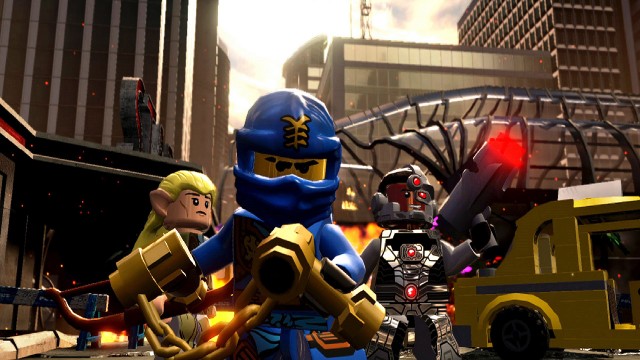
Earlier this week, Disney announced not only the end of the Disney Infinity line of games and toys, but also the closure of the title’s developer, Avalanche Software. Rather than continue to develop games in-house, Disney now plans to license its characters to other publishers and developers instead. The closing of a development team is, unfortunately, not an unusual event, but the announcement speaks volumes about the changing video game industry.
On one hand, it’s not all that surprising to see Disney Infinity come to an end. Like the plastic music instrument craze last console generation, the toys-to-life fad seems to have hit its maximum saturation point. While Amiibo and Skylanders figures continue to perform fairly well for Nintendo and Activision respectively, Disney Infinity and Lego Dimensions toys seem to clog the shelves at a number of retailers, even as significant discounts continue to crop up. Just last week, Target discounted Disney Infinity figures from 40-75 percent off, before any announcement was made regarding the cancellation of the series. Lego Dimensions has seen other, similar price cuts, as well. With a steep price to buy-in, the industry likely couldn’t sustain this many similar titles.
If there is a silver lining for toys-to-life games, it’s the fact that the end of one could help the survival of another. Some have speculated that the end of Disney Infinity could actually help sustain Lego Dimensions. Lego already owns the rights to make figures based on Disney properties, but the existence of Disney Infinity likely prevented Warner Bros. and Traveller’s Tales from adding those characters to another toys-to-life game. With that barrier now gone, the roster for Lego Dimensions could grow considerably. There are, of course, potential hurdles. Characters from Star Wars and other Disney films could be added with little difficulty, but Disney and Warner Bros. might not be fond of the idea of Marvel and DC superheroes mingling in a game. Still, fans would certainly jump at the chance, if the two companies could make it work.

The end of Disney Infinity doesn’t just impact one aspect of the overall industry, however. Perhaps the most alarming bit about this week’s news is the closure of Avalanche Software, a developer that employed nearly 300 people. In a conference call with investors, Disney boss Bob Iger cited the “changing business” of video games as a reason for the studio’s closure, questioning whether the industry itself was “stable enough.”
It would be easy to dismiss Iger’s concerns, but the instability of the video game industry does seem to be a concern for a number of publishers right now. With the ever-increasing cost of game development, low-investment, high-yield profit margins are hard to resist. Given that Disney has quite a bit of experience with mobile, pay-to-play gaming, it wouldn’t be surprising to see the company shift focus that way. Konami disappointed a number of gamers when it announced a complete shift toward mobile gaming last year, and it’s likely it isn’t the only publisher to see the allure.

The closure of Avalanche Software is disappointing, but Disney’s departure from the game development business does not necessarily indicate that mobile gaming will completely take focus. The strength of EA’s Star Wars: Battlefront sales likely played a significant role in Disney’s decision to shutter Avalanche. Reviews for Battlefront were mixed, but Disney properties have found great success in the past when licensed out to other developers and publishers. Star Wars: Rogue Leader and Marvel vs. Capcom are both examples of great games featuring Disney properties that were released by other publishers. The company owns some of the most popular characters in the world; hopefully those characters will be allowed to do more than languish within Candy Crush knock-offs.
The video game industry is in a bit of a transformative period, at the moment. Some of the biggest, most beloved developers have cut costs, taken smaller risks, and even dumped consoles altogether in favor of mobile gaming. The end of Avalanche Software may seem like just another unfortunate closure in an industry that sees them far too often, but it could very well speak volumes about where the industry is heading. Hopefully, that future will remain a bright one.




 ShareThis
ShareThis






Regarding points made in the 3rd paragraph: Yeah that was my first thought: Lego Star Wars are such a big deal, it would only make sense to at least attempt to overcome possible licensing hurdles and to make a “Lego Star Wars Dimension” pack or expansion (or whatever).
I’m not invested in any of these toy-lines (I do own various Amiibo) but yes, I’ve seen Lego Dimensions clogging up shelf space at numerous retailers (even with a seemingly constant 30% to 50% discount). The starter pack can often be found for $50 or $60 (originally $100.)
Many people already know and love their favorite Star Wars heroes in Lego form. The art-style of Infinity toys was polarizing: Some people loved it, yet many found the sight of Darth Vader (for example) in the streamlined angular Infinity style a bit off-putting.
My kids are just old enough to be getting into Legos. If I saw a Lego X-wing fighter in the game section that promised a Rogue Squadron-type gaming experience, I would strongly consider it. They could re-boot the franchise with an emphasis on Star Wars. However with the new Lego Star Wars game just around the corner, it seems like a window of opportunity has been missed.
RIP Infinity. I never bought any of its products, but I always thought I’d buy a “Scrooge McDuck” figure had one ever materialized.
Man, I totally would have snagged Scrooge McDuck. They wanted to make Darkwing Duck, but it never quite materialized. Which is SUCH a shame.